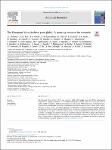The European Virus Archive goes global: A growing resource for research
Romette, J. L.
Prat, C. M.
Gould, E. A.
de Lamballerie, X.
Charrel, R.
Coutard, B.
Fooks, A. R.
Bardsley, M.
Carroll, M.
Drosten, C.
Drexler, J.F.
Günther, S.
Klempa, B.
Pinschewer, D.
Klimkait, T.
Avsic-Zupanc, T.
Capobianchi, M. R.
Dicaro, A.
Ippolito, G.
Nitsche, A.
Koopmans, M.
Reusken, C.
Gorbalenya, A.
Raoul, H.
Bourhy, H.
Mettenleiter, T.
Reiche, S.
Batten, C.
Sabeta, C.
Paweska, J. T.
Eropkin, M.
Zverev, V.
Hu, Z.
Mac Cullough, S.
Mirazimi, A.
Pradel, F.
Lieutaud, P.
The European Virus Archive (EVA) was created in 2008 with funding from the FP7-EU Infrastructure
Programme, in response to the need for a coordinated and readily accessible collection of viruses that could be
made available to academia, public health organisations and industry. Within three years, it developed from a
consortium of nine European laboratories to encompass associated partners in Africa, Russia, China, Turkey,
Germany and Italy. In 2014, the H2020 Research and Innovation Framework Programme (INFRAS projects)
provided support for the transformation of the EVA from a European to a global organization (EVAg). The EVAg
now operates as a non-pro
fi
t consortium, with 26 partners and 20 associated partners from 21 EU and non-EU
countries. In this paper, we outline the structure, management and goals of the EVAg, to bring to the attention of
researchers the wealth of products it can provide and to illustrate how end-users can gain access to these re-
sources. Organisations or individuals who would like to be considered as contributors are invited to contact the
EVAg coordinator, Jean-Louis Romette, at
jean-louis.romette@univmed.fr.
Dateien zu dieser Publikation

